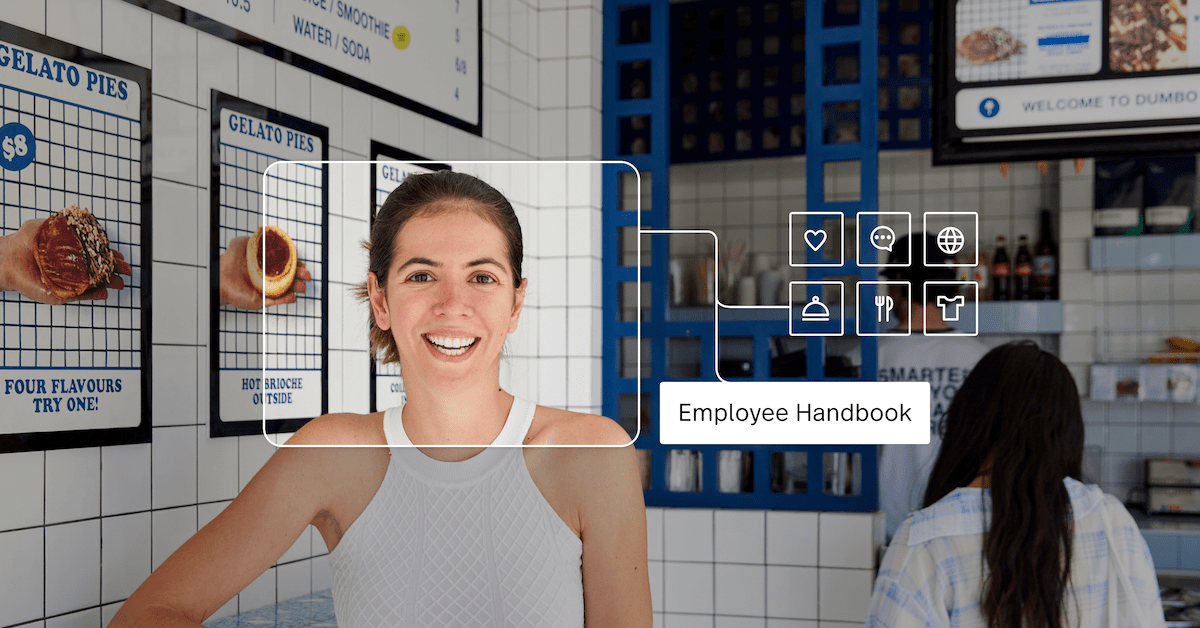
Finding and hiring the best people for your restaurant can be challenging, and holding onto all-star employees can be even harder. For restaurant owners, it can be difficult to dedicate enough time to the recruitment and training process, but these steps are vital when finding the right people and holding on to them.
One of the best ways to ensure your staff retention remains high is to set all new employees up for success from the get-go, and creating an employee handbook is an excellent way to do this.
A restaurant employee handbook is a great resource that introduces new employees to your venue, outlines expectations, and answers any questions they may have. It also aligns your service, kitchen, and management staff on the same goals and sets the tone for a positive work culture that fosters better employee relations and lower turnover.
What is a restaurant employee handbook?
A restaurant employee handbook is an excellent tool for onboarding employees and can be used as a resource for employee management. It serves as a centralised reference point for your restaurant’s mission, values, rules, regulations, policies, procedures, and guidelines.
Your handbook should be given to new employees on their first day, so they know the ins and outs of your restaurant and what’s expected of them. Staff can then keep this at home and refer to it when necessary.
Aside from being a valuable asset for new staff, a restaurant employee handbook is also an excellent tool for building a positive workplace culture. It provides staff and managers with a clear set of guidelines for procedures and behaviour so everyone is on the same page.
Why should your restaurant have an employee handbook?
The first few days in a new job can be overwhelming, and it can be challenging for new staff to remember everything they’ve been taught. To combat this, an employee handbook provides new employees with a reference point for all key information about your restaurant, so they can run through the important training elements and learn more about your business.
Providing staff with an employee handbook maintains a level of consistency when it comes to staff training and management. It also provides existing staff (and managers) with a reference point for procedures and behaviour, so everyone knows the ins and outs of the business and what’s expected of them.
12 things to include in your restaurant employee handbook
- Introduction
- Mission statement & core values
- Restaurant structure
- Employee benefits
- Code of conduct
- Dress code policy
- Leave policy & procedures
- Safety protocols
- Front-of-house and Back-of-house operations
- Scheduling process
- Tech how-to guide
- Complaints procedure
1. Introduction
The introduction to your restaurant employee handbook must be strong and engaging. The better your introduction, the more likely staff are to read the handbook in its entirety.
What to include in your introduction:
- A short welcome note from the founder, owner, and/or general manager
- A brief history of the business
- An overview of the restaurant, how it’s run and any business goals
- Key takeaways on your restaurant’s brand positioning and operations
- An outline of each of the upcoming chapters in the handbook
2. Mission statement and core values
Use this chapter to briefly describe your mission statement, which should outline what your restaurant stands for, the type of service you aim to provide, and your business’s core values.
Your mission statement is the why behind your restaurant’s existence. It informs everything from the food you serve and your style of service to how you want employees to interact with guests.
Sharing the company mission in your employee handbook is valuable for your service and kitchen staff—but it also aligns your management team and helps them make thoughtful business decisions that correspond with your mission.
Once you’ve outlined your mission statement, you should list your restaurant’s core values that you expect staff to embody and adhere to while at work.
Your core values should represent your ideals and how you want your businesses to impact your customer staff and the local community.
These could include:
- Supporting the local economy
- Providing quality service
- Consistency
- Sustainability
- Authenticity
- Creativity
- Passion
Whatever your establishment’s mission and core values are, you ultimately want your staff to align with them and foster an inclusive work culture that’s about more than just clocking in for a shift and making some money.

3. Restaurant structure
In this section, you should outline all the different roles and responsibilities within your restaurant so each staff member knows what they’re accountable for and where they can go for help.
To keep things clear and concise, group roles and responsibilities into three categories; front-of-house, back-of-house and management. This will make it easy for new employees to pinpoint their team and understand where other employee roles sit within the business.
To help make this section more visual, you could also include an organisational chart to clearly emphasise how the hierarchy is laid out and who is responsible for what.
4. Employee benefits
This chapter should outline employee compensation, benefits, and payroll.
It’s crucial to ensure the information in this section is correct and kept up to date to ensure you’re always compliant with local laws and regulations.
What to include in your pay and benefits section.
- Your policy on tips
- Whether or not your establishment practices tip pooling
- How much you pay your employees, as set out by your industry award
- How employees will be paid, e.g. by cash, or direct deposit
- How often employees are paid, e.g. weekly, fortnightly, monthly
- Your policy on overtime
- Superannuation details
5. Code of conduct
Everyone’s definition of professionalism and good service is different, so it’s essential to ensure all of your new staff are on the same page when it comes to behavioural expectations while at work.
Use this section to outline your code of conduct which should communicate everything from your establishment’s dress code to your safety procedures and other policies.
What to include in your code of conduct?
- Tobacco policy – smoking is prohibited indoors, and any employees who smoke must do so outside in designated smoking areas. This also includes e-cigarettes and vapes.
- Phone policy – when and where staff can use their phones and provide a secure location where they can store their phones on shift.
- Behaviour policy – outline what behaviours are unacceptable and the disciplinary process; this could include repeated lateness, tardiness, aggressive behaviour, theft etc.
- Food and drinks policy – when and where can staff eat on their breaks, and what is the policy for ordering food while on shift?
6. Dress code policy
This chapter should include guidelines on how your staff dress while at work. It’s not only a matter of workplace safety but also ensures that what your staff wears aligns with your restaurant’s brand.
Naturally, this is going to vary from one restaurant to another. A fast-casual joint likely won’t expect the same level of dress or finer details that a high-end establishment does.
This section will likely be short and sweet if you require a uniform. Even if your restaurant doesn’t have a uniform, you should use this section to address how you expect staff to dress on shift and what’s not acceptable.
What should your dress code include?
- Haircuts, facial hair, and hair colour policy
- Tattoo policy
- Shoe safety program
- Jewellery policy
- Clothing policy, e.g. no ripped jeans
- Shoe policy, e.g. must have slip-resistant traction
It’s important that your staff understand that what they wear serves as part of your restaurant’s visual identity. What you want your staff to wear is entirely up to you; just make sure that the dress code aligns with your establishment’s brand, that your dress code is communicated to employees, and that they’re held accountable for upholding it.

7. Leave policy & procedures
In this section, you should detail your restaurant’s leave policies, how staff can request leave, and what process they should follow if they’re sick.
Outline your restaurant’s policies and procedures for each of the following:
- Public holidays
- Sick leave
- Annual leave
- Parental leave
- Break and meal times
8. Safety protocols
Use this section to define how each of your staff contributes to creating a safe work environment and the procedures and general guidelines you have in place to keep your workplace safe (like what to do in case of a fire).
Also, mention that an employee’s failure to comply with safety procedures will result in disciplinary action. Show your staff that you take their safety seriously.
In addition to workplace safety, all staff members should be educated on food safety procedures, such as cross-contamination and food allergens. To keep the highest standards possible, ensure everyone (not just the kitchen staff) is educated on food handling procedures and what to do if a customer discloses that they have a food allergy.
9. Front-of-house & back-of-house operations
In this chapter, give a brief outline of your front-of-house (FOH) and back-of-house operations and what’s expected of staff. This will allow new employees to understand the different functions of each department.
Front-of-house operations
This section should cover how the FOH team operates and how they should conduct themselves. Include everything from table management procedures to order taking, greeting customers, accepting payment, and dealing with complaints.
This section is also a great time to talk about customer experience and the service your servers provide.
Address the following points to outline the ideal guest experience in your restaurant:
- How to greet guests. Do you want servers to follow a script or go off the cuff and be themselves?
- Go above and beyond. Whether it’s a new guest with a challenging special request or a VIP with high expectations, train everyone to think beyond the customer’s basic expectations.
- Be genuinely personable. Beyond just being friendly and polite, FOH staff should be aware of opportunities to make genuine connections with guests—even a small gesture like remembering a guest’s name can go a long way.
- Surprise and delight. Highlight to staff what’s acceptable when going above and beyond for a customer, e.g. is there a free drink policy for birthdays or engagements, for example?
Back-of-house operations
Like your FOH operations, this section should include information about how your BOH operates. It can include kitchen safety guidelines, cleaning procedures, how to check inventory, food health and safety guidelines, how to record wastage and how to place purchase orders.

10. Scheduling process
Use this chapter to clearly define your scheduling process and how much notice is expected of your employees when they request time off. Mention that if their requests are not submitted on time, it becomes their responsibility to find a colleague to replace them.
If you use any scheduling platforms, this section should give a brief overview of how staff can access the tool and how it’s used.
What to include in your scheduling processes and guidelines:
- How often the rota is released
- How far in advance the rota is planned
- Procedures for submitting work schedule preferences
- How to request time off
- How to swap shifts with a colleague
- Your policy for absences and tardiness
- A list of your scheduling tools
11. Tech how-to guide
Every restaurant employee handbook should include a how-to guide for your various restaurant tech solutions.
Outline each scenario where your service and kitchen staff will routinely have to use tech – from making reservations to using your point of sale (POS), how to use a kitchen display system (KDS) and how to take payments.
Along with a how-to section, you should also include a list of resources (like how to contact your system’s customer support department) for your staff to refer to if they have any questions or need help.
Part of building a high-performing team is empowering them with versatile, easy-to-use tools and showing them where to go and who to talk to if they have questions or technical problems that require immediate action.
12. Complaints procedure
When it comes to harassment, it’s on you, as a restaurant owner, to take a clear stand. Use this section to first define what constitutes harassment—whether verbal, physical, or otherwise—explain that harassment of any kind won’t be tolerated, and make the consequences for such behaviour crystal clear.
It’s important to reinforce that sexual, verbal, and physical harassment will not be tolerated. You want to foster a safe and healthy environment for your staff and guests. And if any of your guests or staff ever feel threatened or uncomfortable while on the job, it’s on you to make it right and to have a plan of action.
What to include in your anti-harassment and complaint procedure:
- Punishable, fireable, and prohibited offences
- How to report abuse or harassment
- Your management team’s action plan for dealing with violations
Empower your staff with a restaurant employee handbook
Minimising employee turnover and maximising their happiness and productivity starts by hiring the right people for the right job, fostering a safe, positive work environment, and giving them the tools, information, and training they need to feel professionally validated and happy.
While attracting great candidates is one end of the spectrum, having a consistent, professional, organized onboarding process will set a good impression between employee and employer from day one. A restaurant employee handbook can help make that happen.
By creating an employee handbook and using it as a tool to train and onboard new staff, you’ll ensure that you make a professional first impression on new hires while also aligning them with your establishment’s mission, values, policies, and procedures.

News you care about. Tips you can use.
Everything your business needs to grow, delivered straight to your inbox.


